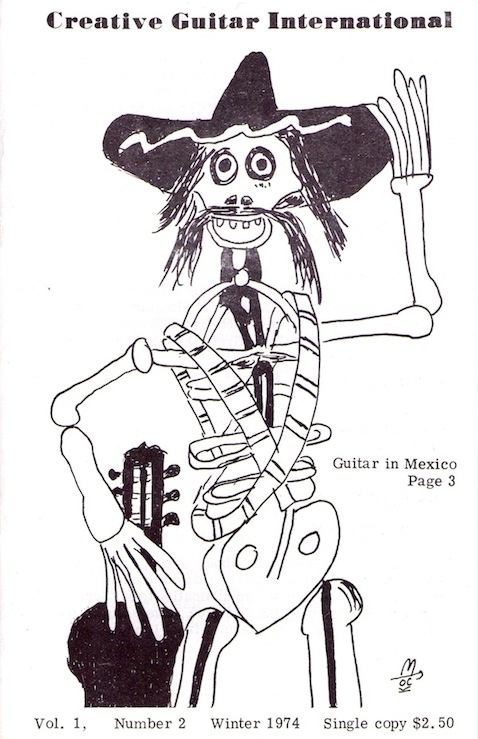
|
|
||
 |
||
Content highlights:
Guitar in Mexico
Training for Classroom
Teaching problems: Materials
|
|
||||
|
creative guitar international
|
contents
Guitar in Mexico 3
A French triumph 7 Contest in Yugoslavia 9 Training for
classroom 10 Teaching problems:
materials 12
A guitar fiesta 22 Guitar, lute, voice
featured 25
Schedule of events 27
Repair book planned 28
From our readers 29
il "Fronimo" 30
|
|||
|
© 1974 by Ruth and Jerry Mock. Creative Guitar International is a classic guitar magazine published three times a year in the fall, winter and spring by Mockingbird Press, Box 1275, Edinburg, TX 78539
Subscription rates $5 a year.
|
Mexico offers a variety of cultures rarely excelled. The foreign traveler who ventures from Mexico City finds in Teotihuacan, a mere 30 miles to the north, an ancient Indian culture, with pyramids, feathered serpents and rain god masks.
In ruins now, Teotihuacan once was a great city built along a broad avenue at least two miles long. In Mexico City itself are the ruins of other pyramids, of the Aztecs, conquered by Spain.
Mexico was one of two centers of pre-Columbian culture in the Western Hemisphere. Therefore, when the Spanish, with their Moorish (African) background, merged with the Indians, a third, equally fascinating culture emerged. That third culture became official with the first Mexican revolution of the early 1800s. Signs of these three cultures--Indian, Spanish and Mexican, are everywhere in Mexico. And they blend to make Mexico unique in regard to the guitar.
The Spanish influence still prevails. The vihuela, long extinct in Spain, remains in altered form as part of the Mexican mariachi, a unique folk orchestra. And the guitar is prominent in Mexican life.
Activity concerning the classic guitar centers in Mexico City. At least three government schools offer instruction in the classic guitar: The Escuela Superior de Musica near the Zocalo; the National Academy of Music near the revolutionary monument; and the Conservatorio Nacional de Musica on Avenue Presidente Masaryk.
 |
|||
|
editor/publisher/Jerry Mock; contributing editors: pedagogy/Ruth Mock; research/Frank Wagner; photography/Howard Cole; Grete Dollitz, Richmond, Va; Ole Vang, Sweden.
Calavera guitarrista
The fellow on the cover guarded a crafts building across from Alameda Park in Mexico City. He is a copy of the famous cavaleras of Mexican artist Posada, and represents the equality of man. The drawing on P. 3 is a danzante of Monte Alban, Oaxaca, on P. 4 a Tlatilco figure. Both represent pre-Columbian art.
QUESTIONNAIRE
The spring issue, due about June 1, will carry a story about our questionnaire, mailed to each subscriber. It has furnished a line of communication to our subscribers, and we will continue the practice of mailing it out, and will carry stories on the results from time to time.
|
||||
|
|
||||
|
|
||||
|
CREATIVE GUITAR INTERNATIONAL
|
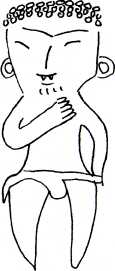 |
as young as seven.
A Canadian youth of college age joined the group. The Canadian said he wrote the conservatory to inquire if he could study there. He said the conservatory asked for a transcript of his grades and required that he get a student visa (which is good for one year.) The Canadian said he paid 500 pesos ($40 U.S.) tuition for a year's study at the conservatory.
The conservatory also has a class in violin and guitar making and repair. Half a dozen youths were taking a course in instrument making and repair that was to last four years. One American was taking the course. Agustin Hernandes Conde, a violin maker, was a supervisor, as was Luigi Lenaro, an Italian-Mexican violin maker.
On South Insurgentes is the studio of Manuel Lopez Ramos, Argentine guitarist-teacher. Lopez Ramos holds workshops mostly in the U.S. and has a sizeable and enthusiastic following. Lopez Ramos is especially respected for his artistic and methodical approach to pedagogy. Lopez Ramos has recorded under the RCA label and two of his proteges, Maricarmen Costero and Mario Beltran, also teachers in the studio, recently made a record as a duo on the Angel label. (See "Creative Guitar International," Vol. 1, No. 1, Fall, 1973).
Another Lopez Ramos protege, Alfonso Moreno, was the first Mexican to win the Concours International de Guitare in Paris, in 1968. The following year Moreno filled the Palace of Fine Arts, a feat only Segovia had been able to do. The following year Moreno performed three works on one program with the symphony: Ponce's "Concierto del Sur," Rodrigo's "Concierto Aranjuez," and the "Concerto in D Major," Op. 101, by Joseph Haydn,
|
||
|
A recent visit showed the national academy full of children, studying various instrumental and musical subjects. A youth about nine awaited guitar lessons with a method by Gaston for young guitarists. Elsewhere in the courtyard one youth played from the Sagreras method while another practiced a piece by Tarrega. Inside two men taught young guitarists. The bulletin board detailed an eight-semester course for older students which included harmony, counterpoint, folklore and string instruments.
|
||||
|
Also in the courtyard were dozens of children who attended the academy in the afternoon after spending five hours at a public school. There were very small children using small instruments. When asked what violin music was used, a youth produced a copy of Haydn's Austrian Hymn. A six-year-old girl sang the hymn in solfeggio (do-re-mi) and a four-year-old played a Stephen Foster melody on the violin, then played pizzicato because the other children asked her to play her violin like a guitar. The other children made a circle around the children playing and listened attentively. Cost of the lessons and classes was extremely modest by U.S. standards.
The conservatory is spacious and modern. Guitar teachers include AlbertoSalas, GuillermoFlores, Miguel Alcazar, Selvio Carrosoza, Pedro Salcedo and Sergio Castillo. Castillo was having a refreshment at the school cafeteria. He has studied under Jesus Silva and attended a Segovia workshop and had studied the past summer in Vienna. Castillo uses the Pujol method and has students
|
||||
|
|
||||
|
|
||||
|
CREATIVE GUITAR INTERNATIONAL
transcribed for guitar by Moreno. In 1973, Moreno was concertizing in Europe.
The Lopez Ramos studio has six teachers, including Ramos, and a little more than 100 students, with a waiting list of 40. The teachers are trained in the Lopez Ramos methodology and most have completed his seven-year program of study. Beginners are accepted with a minimum age of 12.
Mexicans love the guitar and wherever the traveler
|
7
A French triumph
|
|||
|
Three Frenchmen took the first three performance prizes at the 1973 Concours International de Guitare in Paris. It was the first time a Frenchman had placed first in the contest.
The winner was Arriaud Dumond; second was Rafael
|
||||
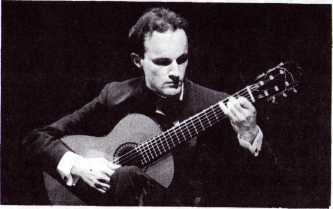 |
||||
|
goes he can find a unique place. He might, for instance, find himself in San Miguel deAllende, Guanajuato, at the Belles Artes, where Angel Arellano teaches classic guitar. ThoughAngel studied in Mexico City, he prefers the beauty of colonial San Miguel, where the building fronts are unchanged, to retain the colonial flavor. As Angel says, every street is beautiful in San Miguel. Angel plays many styles,
|
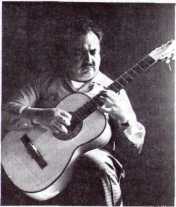 |
|||
|
WINNER DUMOND PHOTOS BY ORTF
|
||||
|
Andia; third was Ramond Couste; and first accessit was Erika Pircher of Austria.
Only one composition was awarded a prize: "Four Preludes" for guitar by Jackques Cerf of Switzerland.
Twelve countries were represented by 41 entries in the performance contest, and 14 countries represented by 67 composition entries.
|
||||
|
ANGEL ARELLANO
|
||||
|
but perhaps does best at improvising. Only recently, he improvised his beautiful melodic lines over the local radio station while two men read tributes to three Pablos who died recently: Spanish artist Pablo Picasso; Spanish cellist Pablo Cassals; and Chilean poet Pablo Neruda.
In the Spring, 1974, issue of "Creative Guitar International: Part II, Mexican music and luthiers.
|
||||
|
|
||||
|
|
||||
|
CREATIVE GUITAR INTERNATIONAL
|
9
|
|||
|
|
||||
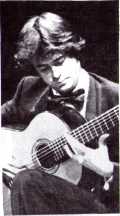 |
First eliminations for the 1974 contest were scheduled during February, with a jury auditing tapes. The contest, sponsored by the French Broadcasting System, will be during February, with a jury auditing tapes. The finals will be held in Paris. The 1973 finals were held on Oct. 27-28 in the Theatre des Champs Elysees.
The 1974 performance contest is for both solo and duos while the composition contest is for solos. Music assigned solo performers was: "Deux Sonates" (S K No. 74 et S K No. 80) by Carlos Seixas, revision Javier Hinojosa, Gitarren-Archiv Schott 237, Ed. B. Schott's Sohne, Mainz; "Invocation etDanse" En Horn mage a Manuel de Falla, by J. Rodrigo, Editions Francaises de Musique Technisonor 12, Rue Magellan 75008 Paris;"Prelude (I) et Danse (IV)" de la"Suite Latine" pour guitare by Guy Morancon, doigtee par Konrad Rogossnig, Editions Max Eschig, 48, Rue de Rome, 75008, Paris.
Music assigned for duos was: "Preludeet Fugue No. 12" du "Clavier Bien Tempere" by Jean-Sebas-tien Bach, transcription Jorge Mar-tinez-Zarate, Ricordi, BA 12847, Editions Ricordi-Americana, Can-gallo 1558, Buenos Aires, Argentine; "l'Encouragement," Op. 34, by F. Sor, Editions Musikverlag Wilhelm Zimmerman, Frankfurt am Main,
|
Allemagne Federate; for U.S.A., C.F. Peters Corp., New York; for British Commonwealth, Novello et Co., Ltd. , London; and "Micro Piezas" pour deux guitares by Leo Brouwer, Editions Max Eschig, 48, Rue de Rome, 75008, Paris.
Producer of the Paris contest is its founder, Robert J. Vidal.
|
||
|
Contest in Yugoslavia
|
||||
|
A guitar category has been set for the fourth annual Competition of Juenesses Musicales to be held in Belgrade, Yugoslavia in the fall. The contest is open to contestants under 30. Following is the music to be performed on three tests:
Test 1: M.M. Ponce: "Theme varie et Finale," Ed. Schott G.-A. 109; J. Turina; "Fandanguillo," Ed. Schott G.-A. 102; andF.M. Torroba: "Nocturno," Ed. Schott A. 103.
Semifinals: T. Prosev: "Mutations for Guitar." One of the following sonatas: M.Guiliani: "Sonata" Op. 15, Ed. Universal, Wien; N. Paganini: "Grand Sonata" in la (A major), Ed. Ricordi S. Y. 469, to be played without violin; F. Sor: "Sonata" Op. 22, Ed. Simrock, GMBH (Max Eschig). One of the following compositions: H. Villa-Lobos: "Etude No. 7," Ed. Schott G. -A. 180; E. Pujol: "Guajira,"Ed. Max Eschig 1204; and J. Jovicie:"Theme, Varation and Oro" from the "Macedonian Rhapsody."
For the finals, one of the following concertos: M. Castelnuovo-Tedesco: "Concerto in D,"Op. No. 99, Ed. Schott G.-A. 166; H. Villa-Lobos: "Concert pour guitare et petit orchestre (Concerto for Guitar and Small Orchestra)," Ed. Max Eschig; and J. Rodrigo: "Concierto
|
||||
|
ANDIA
|
||||
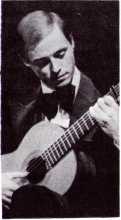 |
||||
|
COUSTE
|
||||
|
|
||||
|
|
||||
|
CREATIVE GUITAR INTERNATIONAL
de Aranjuez."
Entry deadline is Aug. 15. For information write: The Secretariat of the International Competition of Jeunesses Musicales, Terazije 26/1, 11000 Belgrade, Yugoslavia.
|
11
|
|||
|
demand for such curricula at all levels requires the development of a method specifically designed for use in music teacher preparation programs which will enable the music educator to incorporate the guitar into the school music program effectively."
|
||||
|
|
||||
|
Dr. Pets chauer's dissertation was written under the guidance of
|
Research
|
|||
|
|
||||
|
Dr. Roy Petschauer of the Washington State University department of music said he hopes his dissertation will "break the ice and create a more favorable climate for acceptance of topics related to teaching the classic guitar."
Dr. Petschauer's 1972 dissertation for the University of Oregon included a method to train classroom teachers and music specialists at the college level.
His method included teaching and performance techniques, as well as information on care, construction, history and literature of the guitar.
His dissertation included a study on the abilities of 18 students before and after taking a course on guitar techniques based on his method. Prerequisite for the course was the ability to read music and possession of a classic guitar.
In his introduction, Dr. Petschauer states:
"During the last few years, music educators have expressed a mounting concern over the need for and the role of guitar playing and guitar instruction in the schools. It is apparent that for the next few years, an improvement and expansion of guitar curricula are imperative. The
|
the education department. He relates that the music department |
Contributing editor Frank Wagner
|
||
|
"had no one competent (they felt) to evaluate the method and they were unwilling to accept the word of professional guitarists whom I might solicit for comments on the text itself." |
||||
|
Therein lies the dilemma of the student who dares to tackle a different subject. It also is the dilemma of the universities: Where do you find a teacher of classic guitar when no one is qualified? Who is to judge a guitar method when even guitarists disagree about methods ?
In some programs, colleges use consultants who are not professors in the traditional sense. Christopher Parkening chose the University of Southern California because of its excellent music department. Since there was no guitar teacher, he was listed as a cello major. Of course, Parkening already was an excellent guitarist when he entered USC. Even so, schools need an imagina-five approach to solve the dilemma of educating the aspiring guitarist. As Dr. Petschauer wrote: "The more commonplace guitar dissertations become, the more insupportable will be the arguments which I had to face when my proposal was rejected by the music department at U of O."
Dr. Petschauer is still rewriting and revising his
method and hopes "to get it into some sort of shape within the next year or so. "
|
||||
|
|
||||
|
|
||||
|
13
He replied that the right hand fingers were not paralized, so why not use them!
Michael F. Wright, chairman of the Guitar Department of the Wisconsin School of Music wrote "...my policy is to steer everyone toward eventual classical repertoire and technique, my theory being that, besides aesthetic considerations, almost all styles can be played classically, whereas the classical repertoire demands more rigid technical emphasis. All of my students are now 'classical' even though they originally started for something else."
Reading the notes presents a problem to some beginners. In the beginning stages of guitar I do not stress the letter name of the note unless the student knows the lines and spaces or indicates a particular interest in calling the note by the letter name. The combination of right hand finger, rest or free stroke, left hand fingering, six strings, a good sound production, rhythm and steadiness are quite enough for a start. Sometimes a mother becomes upset because her child can play every note on the page, but cannot tell her the letter name. I explain that the names will come, but that he has enough to do with the physical execution of the sound.
The student who finds reading extremely difficult may play the first few studies of Sagreras keeping his right hand i (index) finger on string 3, m (middle) finger on 2, and a (ring) finger on string 1. Since his right hand fingers do not move off these strings at first, he can concentrate more on the left hand fingerings, but read the ima's at the same time, getting both hands to work on the same string. I usually begin with No. 46 because of the easy a minor key.
|
||||
|
The teaching problems discussed in the Fall issue of "Creative Guitar International" (Vol. 1, No. 1) were parental participation and use of the beginning method, The Mock Family Classic Guitar Method, Vol. 1_. This chapter concerns: 1. Follow-up methods used by me for the next two years. 2. The use of the metronome. 3. Chamber music for the beginning guitarist.
|
||||
|
METHODS
|
||||
|
Guitar teachers sometimes feel frustrated because of a lack of satisfactory teaching material. One subscriber wrote: "There is such a dearth of
|
||||
|
material for younger students (or
|
Pedagogy
|
|||
|
older for that matter.)" Another wrote, "I have yet to find (a method) that is the whole answer, and probably will never in my lifetime see one... it is a question of finding the
|
||||
|
Contributing editor Ruth Mock
|
||||
|
one or two that most nearly hit the mark.
|
||||
|
■ Upon completion of the Mock Method, I go immediately into Julio S. Sagreras' method, Vol. 1. Sagreras comes in seven progressive volumes. Its unique characteristic is the complete fingering for both hands, including indication of the rest stroke. My students often ask for a chord book. I show them Sagreras, play several studies, explain what chords I am using and that I read by chords, but by standard notation, like a pianist or violinist reads. The technique of the right hand "sells" them on my "chord book. "
Many students of the guitar do not really know what they want to do on the guitar. They just want to play it!
One unsuspecting teacher listening to a guitar workshop we presented asked my husband why we did not strum.
|
||||
|
|
||||
|
|
|||
|
CREATIVE GUITAR INTERNATIONAL
Wynn Smith, program director of the Seattle Classic Guitar Society, member of the Washington State Music Teachers Association and the American String Teachers Association, wrote: "I find written work to start is one way to establish the basic facts of music. EGBDF and all that seems to stick better after one has to write it down. I make up sheets of games and puzzles... to encourage this mental certainty of the names of notes..." (See Wynn Smith's puzzle, page 15).
Although not necessarily progressive, Carulli Vol. 1 (Spanish edition) is melodic and romantic. However, the right hand is not fingered and the teacher needs to finger the right hand carefully and indicate the use of the rest stroke. More advanced students may want to finger their own and check it against the teacher's copy. My beginning students copy the fingering of my book before practicing each study. Depending on the age and amount of practice, I assign one Sagreras and one Carulli Study a week and urge the student to move on to improve his reading. Unless the student can read Sagreras without too many problems, it is best to wait on the Carulli. I have found many guitarists who play well, but cannot sight-read because they do not read new music each week in a methodical way. I suggest the student divide his time on Sagreras and Carulli. Later he will divide his time in thirds, with technique taking the other part. (In the spring issue I will discuss the technique I use for beginning students.) I use the first two Carulli volumes.
METRONOME
I use the metronome for all practice of Carulli and Sagreras studies. The speed is determined by how steady the student can play the study without mistakes. For example, the time signature of 4/4 with four groups of
|
15
|
||
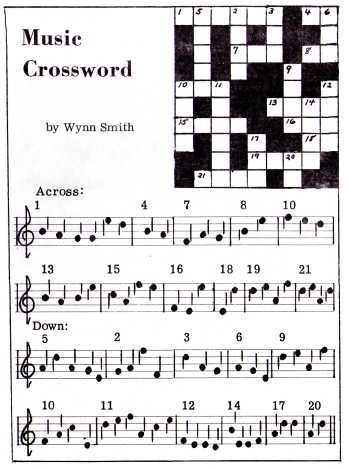 |
|||
|
|
|||
|
|
||
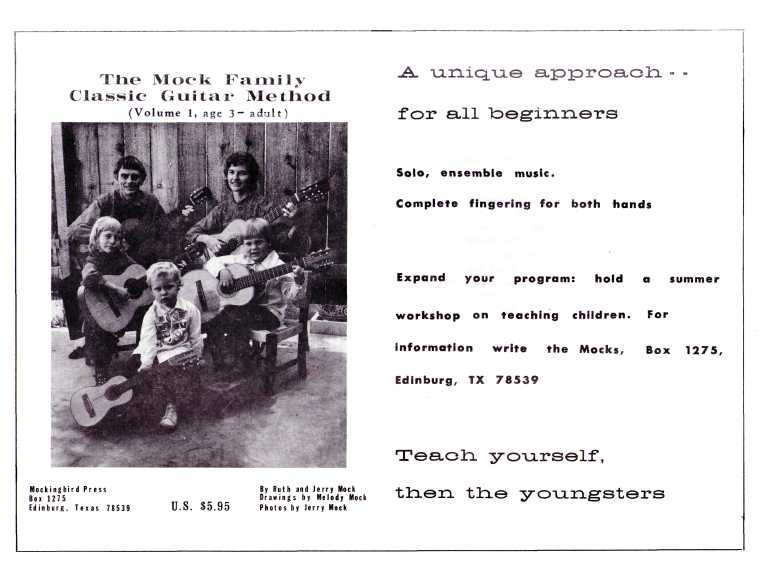 |
||
|
|
||
|
|
|||||
|
CREATIVE GUITAR INTERNATIONAL
|
19
|
||||
|
|
|||||
|
triplets may sound best when played at •' = 80. The beginner may need to play each note of the triplet to 60, gradually increasing to 180. I usually increase speed by skipping every other number. At 180 to each note, he can reduce the speed and play the triplet to 60, increasing his speed until he can play the triplet at 80. My students write in the metronome speeds and at the end of the week's practice can see their progress, with a line of numbers stringing across the page.
One of my five-year-old students asked his mother when she was going to buy that "box." Young children often respond better to the sound of the metronome than to counting the numbers of the beats in the measure. They usually enjoy playing with the metronome. Sometimes a student will fight the use of the metronome, but will suddenly surprise me with, "Turn it on, I can play it at 72!" It is very obvious which students practice with a metronome because of their steadiness.
Steadiness is a serious problem with many musicians, including those participating in chamber music. I have never felt that my students play mechanically (which is often the criticism of the use of the metronome by non users.) Rather, the progress of steady tempo is very obvious as the student sees on paper that last week he could play at 60, but this week it moves at 80!
I also use the metronome for chord changes. For example, the change from one chord to another may take four counts at 60, but with some practice a student may learn to change in three beats, two beats, one beat, and then move his tempo faster. We practice the Sagreras chord changes with the metronome in this way before playing the study.
|
I personally wish that teachers would not only recommend metronomes but would require them. Some of the non electric metronomes tested by my students with my Franz electric have been uneven. Therefore I recommend the Franz electric. After Maricarmen Costero per -formed at Pan American University in Edinburg, TX (see cover story, Vol. 1, No. 1), I asked her opinion of the metronome. She replied that she tells a new student to buy a metronome first, then a guitar!
President of the Franz Manufacturing Company, Miss Ruth Franz wrote that she read our magazine with interest as she has a guitar. The Franz company has been most cordial and prompt to all correspondence.Our five-year -old and the eight-year-old each has a metronome. My own has been used for a number of years. One metronome was returned to the fac-
|
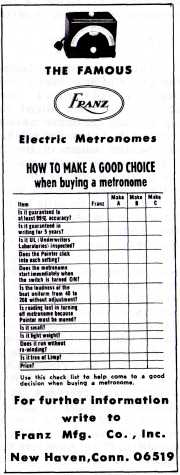 |
|||
|
|
|||||
|
|
|||
|
CREATIVE GUITAR INTERNATIONAL
|
21
|
||
|
|
|||
|
tory with a $1 during its five year guarantee and was returned immediately in perfect shape.
CHAMBER MUSIC
j
I am a very strong believer in chamber music with the guitar after a year's study or upon completion of Sagreras I and Carulli I. Before this time, interested students will often attend chamber sessions, perhaps playing only one or two notes to the measure at first, but learning to follow the notes. John Celentano, director of chamber music of the Eastman School of Music ("American String Teacher," Autumn 1973), discussed the lack of musicianship in string players who plan a college career in music, even though they may play well by themselves. He calls the string quartet the laboratory for learning the basic elements of music such as rhythm and intonation. He suggests a regularly scheduled chamber music session. Unfortunately, some guitar teachers do not provide opportunity for chamber music because they may lack a repertoire of chamber music in their own libraries and may be unfamiliar with music written for the guitar. Also, they may lack the string players with whom to perform. Fortunately we draw upon Pan American University across the street from our studio. One way of finding the names of amateur chamber music players is to write Amateur Chamber Music Players, Box 66A, Vienna, VA 22180.Separate directories are published for the U.S.A. , Canada, Mexico, Central America and overseas. In the 56 pages of the 1972 directory, I found 16 guitarists, many of whom also played another string instrument. I would like to see more guitarists join. ASTA also solicits classic guitar members. Write American String Teachers Association, Robert C. Marince, Executive Secretary, Lawrence Public Schools, 2455 Princeton Pike, Trenton, NJ 08638.
|
Chamber music with the guitar is a pleasant way to spend a Sunday evening. The Amateur Chamber Music Players' November, 1970 newsletter carried a reprint of an article in the Los Angeles Times of Feb. 13, 1970, describing chamber music as "the long-awaited escape from the bondage of television, from the torpor of spectator life, from the punishing ritual of the cocktail party..."
A good way to stimulate the chamber sessions is to provide an opportunity for performance. Wynn Smith wrote that the Seattle Classic Guitar Society meets "monthly for a business meeting (no longer than five minutes of announcements, etc!) and then puts on a program of one and one-half hours followed by a coffee hour." The Amigos de la Guitarra Clasica of South Texas does the same. The Audience generally consists of relatives of performers--a most enthusiastic and sometimes captive audience! Students of violin, viola and cello often double on guitar, and sometimes go on "tour." Holidays and anniversaries are great occasions for guitar parties. Nov. 3 the Friends of the Corpus Christi (Texas) Museum presented, in cooperation with "Creative Guitar International," a "Grand Fiesta of the Classic Guitar" in honor of the 180th birthday anniversary of Stephen Austin. The all-day guitar festival included Baroque, Classic and Mariachi music. (For photos, please turn to pages 22-23.)
The following is a partial list of music I use during the first two years of guitar study. I suggest you write for the current catalogues.
From Belwin Mills Publishing Corp., Melville, NY
11746:
METHODS: Sagreras, J.S., Vol. 1, BA 9500; Vol. 2,
............continued on page 24 |
||
|
|
|||
|
|
||||
|
CREATIVE GUITAR INTERNATIONAL
|
23
|
|||
|
|
||||
|
A guitar fiesta
|
Photographs
by Howard Cole
|
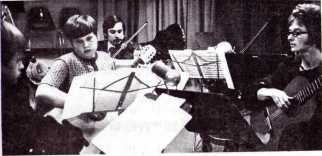 |
||
|
Four guitarists doubled as string players for a recent "guitar festival" in honor of the 180th birthday of Texan Stephen Austin at the Corpus Christi, TX, Museum.
Playing the Rode "Trio in Re" for guitar and strings are Cindy Cole (below right), 16, viola; Nelson Mock (below left), cello, with Jerry Mock, cello. Nelson plays an upside down viola in the position of a cello, with a cello stand made for him by A. A. Miller, violin maker of Corpus Christi.
Edward Miner. 10. and Joe Ranson, 12, play the
|
||||
|
"Pastorale" of the Boccherini "Quintet in D" for guitar and strings with their teacher, Ruth Mock (top right). In the background are Mike Corte's, violin, and the other violin bow belongs to Melody Mock, 7, also a guitarist.
In the grand finale (bottom right) of mariachi music, the four string players perform on guitar. Guitarists are, clockwise from right, Nelson Mock, Ruth Mock, Cindy Cole,Edward Miner, Joe Ranson,Melody Mock and Jerry Mock. Standing, from the left, are Norma Cardenas, viola, and Mike Cortes and Dr. Thomas Greer, violins.
The program was sponsored jointly by the Museum and "Creative Guitar International."
|
||||
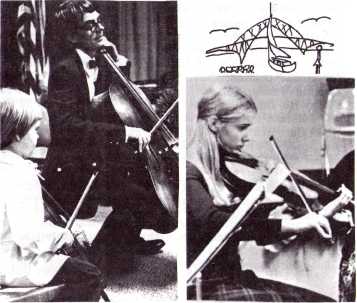 |
||||
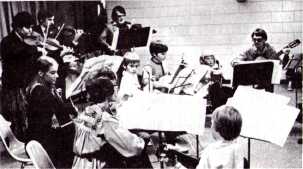 |
||||
|
|
||||
|
|
|||
|
CREATIVE GUITAR INTERNATIONAL
|
25
|
||
|
|
|||
|
9529; Carulli, F. (Spanish text) Vol. 1, BA 115, Vol. 2, BA 116.
GUITAR DUOS: Kuffner, J. , "60 Study Pieces," Op. 168 (Goetze), GA 9; Carulli, F. , "Six Little Duets," Op. 34 (Goetze), Book 1, GA 65; Book 2, GA 66; "12 Romances," Op. 33 (Goetze), GA 68.
GUITAR TRIO: Call, L. "Trio in C," Op. 26 (Goetze), GA 61.
GUITAR AND PIANO: Diabelli, A., "30 Pieces," (Meier), GA 22, 23, 24 and 25 (four books). The piano needs very little pedal and a light touch. These are delightful pieces and fun to play, double or triple on parts.
GUITAR, VIOLIN, VIOLA AND CELLO: Rode, Jacques Pierre (1744-1830)-Abel Nagytothy-Toth, "Trio in D." (Our music reads Ediciones Musicales Madrid, C. Mayor, 27, Madrid 13, Espana).
From C. F. Peters Corp. , 373 Park Avenue South, New York, NY 10016:
QUINTETS (string quartet and guitar): Boccherini, ZM1044, No. 1 (D) (The Pastorale is beautiful and very playable); ZM1153, No. 2(C), "La Ritirata di Madrid," (The l2 variations at the end are very entertaining and programatic, depicting the marching of troops); ZM1163. No. 3 (e minor) (Minuetto and Trio): Schnabel. J. . ZM1275 (the only quintet Schnabel wrote with guitar. The minuet is very easy and the rondo playable.)
The more advanced students can play all the movements, but the above are suggestions for students with about two years' experience. Don't miss the Fandango of
|
the Boccherini in D. We call it the FUNdango because it really is fun! It is a fantastic contrast to the lovely Pastorale of the second movement, for it takes on the flavor of the cafe and dance of Spain. Boccherini lived in Spain and as a cellist and guitarist wrote well for both instruments.
VIOLIN AND GUITAR: Gragnani, sonatas, Op. 8, ZM1047, No. 2 (C) Adagio, also Nos. 1 and 3.
VIOLIN (FLUTE), VIOLA, GUITAR (LUTE): Call, ZM1045, "Trio," Op. 134, E flat. (This entire trio is not difficult for the guitar. I have performed it with both violin and flute, but prefer the flute for the contrast. The guitar must use a capo at the third fret or a terz guitar, which is a smaller guitar turned up a third, is needed).
GUITAR QUARTET: Carulli, "Quartet," Op. 21, ZM1273; and Sor, "Quartet," Op. 15, ZM1274. There is much more music available for the beginning guitarist in chamber music. I would like to invite the readers to send in suggestions for this list, indicating which parts might be helpful for the beginner, where published and where available.
The next chapter will discuss technical studies to accompany Sagreras and Carulli, the use of the tape recorder as a teaching device and a continuation of chamber music with the guitar. There will also be a brief story by contributing editor Grete Dollitz on how she "wangles" her way into public schools to play for the third through fifth grades, what she plays and the questions they ask. Ruth Mock
Guitar, lute, voice featured
Joseph Mayes gave a recital as lutenist with Bonnie Hall, mezzo-soprano, on the first half, and as a solo
|
||
|
|
|||
|
|
|||
|
CREATIVE GUITAR INTERNATIONAL
|
27
|
||
|
|
|||
|
classical guitarist the second half of a program recently at Randolph-Macon College, Ashland, VA.
The first half of the program consisted of songs for lute and voice by English Renaissance composers. The second, guitar portion, included: "Prelude" by J. S. Bach; "Passacaille" by S.L. Weiss; "ElTestamento de Amelia" by Miguel Llobet; "Largo" from "Fantasia No. 2" by Fernando Sor; and "Grand Overture," Op. 61, by Mauro Guiliani.
REVIEWS Mrs. Grete Dollitz wrote the following review of the recital: "Mr. Mayes' lute playing sounded somewhat hesitant as though he were getting over a case of 'nerves' at the start. The pieces were all too familiar and too brief and I wonder if the lute could be heard any further back than the fifth row. The voice was more powerful than the instrument. But it was a very enjoyable segment of the evening's performance.
"And the guitar playing was very competent after a very brief intermission. With the sound of the lute still in our ears we expected a fuller tone from the guitar, but it was not quite the marked contrast as expected. Mr. Mayes may not be too experienced with halls like Blackwell auditorium and his attack was too soft. He played a Ramirez guitar and not the one as mentioned on the program. (The program indicated Mr. Mayes' guitar was made especially for him by Lorenzo Pimentel of Albuquerque, MN--ed.)
"It was a thoughtful performance, carefully planned, and one got the impression as though the performer were
|
very much involved in the music. The audience demanded (and got) three encores. Andwhile this reviewer disagrees with the "Recollections of the Alhambra" as an encore, it nevertheless showed off a smooth tremelo. The last encore was a brief piece written by the performer and left one wondering if there could not have been a little more of it for it was intriguing."
Schedule of events
(Please submit event schedules as far in advance as possible and be as complete and specific as possible. Editorial deadlines for "Creative Guitar International" are: spring, May 1; fall, Sept. 7; and winter, Jan. 7.)
FUTURE
SPRING, Seattle, WA, Young Artists Festival, grades 5-12, includes classic guitar section. (50 entries in spring, 1973, with Alice Artzt judge.) JUNE 10, Spring Hill College, Mobile, AL 36608, master class, Manuel Lopez Ramos, three weeks. Performance by duo Costero-Beltran. JULY 20-AUG. 3, Groznjan, Yugoslavia, advanced training course in guitar (tentative. For information, write Jeunesses Musicales of Croatia, Trnjanska b.b. , 41000 Zagreb, Yugoslavia.) JULY, Aries, France, Secondlnter-national Guitar Meetings.) FALL, 1974, international guitar competition, Belgrade, Yugoslavia. FALL, 1974, international guitar competition, Paris.
CURRENT
MARCH, Sixth Annual Guitar Week in the Theatre de la Ville in Paris, with Christopher Parkening, U.S.A.; Laszio Szendrey Karper, Hungary; Abel Carlevaro, Uruguay; Carlos Barbosa Lima, Brazil; and Jan and
|
||
|
|
|||
|
|
|||
|
CREATIVE GUITAR INTERNATIONAL
Barbara Polasek, Czechoslovakia and Germany. MAR. 14, Leona Boyd of Toronto, Canada, Seattle Pacific College, Seattle, WA. FEB. 25-MAR. 8, Ann Arbor, MI, master class and concert by Manuel Lopez Ramos. PeWormer, $125, auditor, $50.
|
29
|
||
|
From our readers
|
|||
|
The following are excerpts of a letter:
"I think you'll compare favorably with'Guitar News' as you gain expertise in all the related problems...I think you're making the same mistake about Ramos that others made and still make about Segovia. Neither is a god. ..I wish (the Costero-Beltran duo) would work on original material instead of transcribing piano literature.
"I think one should be a musician first, and then a guitarist.. .1 am outraged: romantic Bach? I don't believe you can equate Baroque music and Romantic music... Romantic Bach would label V. O. Bickford who feels as do too many, that the "Chaconne" sounds better on the guitar than the violin. Nonsense!.. .A guitarist who has a true musicality will not assert the cello suites really work on guitar. . .We'd all probably kiss your feet if you'd tell us how to get the (Costero-Beltran) record!
".. .Most exciting for me was your section on guitar with cello. One canonly hope someone will create original material for the Kates.. .Hans Ulrich Stoeps has written a work titled "Gitter Und Ranken," published by Moeck, No. 376, for guitar, alto glockenspiel, alto recorder and tenor recorder...
"About the Appleby's. Perhaps if you asked him to write a poem for your use, he might oblige..."
C. Lynn Brown, Washington, ML
(Editor's note--The Costero-Beltran record is available in Mexico.)
"I have a C.F. Martin & Co., N.Y., guitar that needs attention. Any suggestions who could repair it? Dr. F.L. Carbaugh, Independence, MO.
|
|||
|
RECENT
FEB. 15, Richmond, VA, Sinfonia under Jacques Houtmann, premier performance of "Concertino for Guitar and Chamber Orchestra," by Andre Casanova. FEB. 15, recital by Carlos Barbosa-Lima, and FEB. 11-17, master classes by JohnW. Duarte, both at The Guitar Workshop, Oyster Bay, NY. JAN. 31, Lisa and Evangalos Assimok-oupoulos of Greece, Seattle, WA. JAN. 27, Christopher Parkening, El Camino College, Torrance, CA. JAN. 5, Reyde la Torre, Los Angeles. NOVEMBER, DECEMBER, 1973, Third Annual Guitar Festival in Angers, Amiens, Douai and Chaton, France. Performers included Cuban Leo Brouwer, Czech Barbara Polasek with cello; and the Venezuelan Alirio Diaz. 1973, Dik Visser of Amsterdam, Holland, recital at Seattle, WA.
|
|||
|
Repair book planned
|
|||
|
Don Teeter, Oklahoma City guitar repairman, "closed my shop for nine months and put down just about everything I have learned" in a book to be published by University of Oklahoma Press, "The Acoustic Guitar: Adjustment, Care, Maintenance and Repair." Teeter's shop was selected in 1970 as one of four shops outside the factory that they deemed qualified to do actual warranty work for the C. F. Martin guitar firm. Teeter's outline indicates his book will be a comprehensive repair manual. Jim Powell of Oklahoma City plans to review the book when it is published and interview Teeter for "Creative Guitar International."
|
|||
|
|
|||
|
|
|||
|
CREATIVE GUITAR INTERNATIONAL
Mike Longworth of the C. F. Martin & Co. , Inc. , wrote that a "guitar bearing the label, 'C.F. Martin & Co. . New York' would have been made between 1867 and 1898. Many of the guitars made late in this period have the date written on the underside of the top in pencil."
Returning and shipping instructions have been forwarded to Dr. Carbaugh.
John S. Amorin of Ingleside. TX, writes he would like "to see some attempt made to show actual samples of finger picking as done by people like Chet Atkins, Doc Watson and Merle Travis. Amateur guitarists are often frustrated by being able to play something by Sor and unable to play simple folk music."
Aaron Shearer in his Classic Guitar Technique, Vol. 1, compares playing the plectrum and classic guitars and concludes: "For the beginning students the classic guitar is unquestionably more rewarding and actually easier to play. "Shearer adds that melodic solos can be played with the thumb and fingers of the right hand, permitting "the execution of widely spaced harmonies of two or more notes simultaneously."
Dr. Roy Petschauer of Pullman, WA, writes that the first issue of "Creative Guitar International" "seemed to indicate a bias on the part of the editors toward" the flat hand position. Petschauer added that "Although I employ the 'flat band' myself, I can picture readers who employ other techniques.. .1 hope you will include other techniques and performers in the next issues to dispel any doubts."
|
31
|
||
|
il "Fronimo"
|
|||
|
il "Fronimo" is an Italian guitar and lute publication with a summary of titles in English. It is edited by RuggeroChiesa. Published four times annually, it contains musicological, historical, technical and critical articles.
Here are some titles from past issues: "Aspects of Guitar Music of the Twentieth Century" by Angelo Gilardino." "Notes on Research into the Ethnic Origins of the Guitar and the Lute," by E. FaustoCiurlo; "Padre Basilio; An Enigmatic Figure" by Franco Poselli; and "Interview with Hans Werner Henze."
Chiesa has transcribed the works of Da Milano and Milan for guitarists and lutenist.
il "Fronimo" is published by Presso le Edizioni Suvini Zerboni, 20122 Milano, Corso Europa 5/7, Italy.
|
|||
|
"GUITAR REVIEW"
"Guitar Review" is seriously considering reissue of its early back issues, probably the first four to six in one volume.
LOPEZ RAMOS METHOD
Manuel Lopez Ramos is planning to publish his own method, his coordination exercises and some pieces including transcriptions by Maricarmen Costero and Mario Beltran (for story on transcriptions recorded by the Costero-Beltran duo see Vol. 1, No. 1, "Creative Guitar International)."
|
|||
|
|
|||
|
|
||
|
32
REVIEWS
"Classic American Folk Songs for Voice and Guitar," Harvest Series, Vol. 1. $2.25, The Guitar Workshop, Box 697, Oyster Bay, NY 11771.
Three nicely arranged songs for Voice and guitar, "for the professional singer or accompanist, as well as the advanced student of classic guitar technique and folk song style." Not overly difficult for an intermediate guitarist at modest tempi, but the middle song needs right hand fingering.
This type of arrangement deserves wider usage. It shows how folk-type music arrangements can be improved.
"The Ronny Lee Classic Guitar Method," Vol. 1. $2.50, Sam Fox Publishing Co., Inc., 1540 Broadway, N.Y. 10036.
Right hand fingering revision is needed. There is too much rest stroke on the thumb, and incorrect use of the rest stroke of the fingers, and little use of the "a" (ring) finger. Also needs revision of chord progressions, inversions, phrasing, etc.
JUST RECEIVED
Manuel Lopez Ramos will present a master class July 1-12 at the University of California, Riverside. Auditors can gain university credit by writing and handing in their notes and observations by the last day of the class. Interested students can contact Patrick Read, 1027 North Coast Highway, Laguna Beach, CA 92651.
|
||
|
|
||